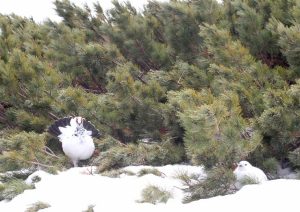On the conservation of Ptarmigan (Lagopus muta)
Hitoshi Murai
Toyama Municipal Family Park Zoo
The miracle bird, Rock ptarmigan
The rock ptarmigan (Lagopus muta) is widely distributed in the arctic regions of the northern areas of the northern hemisphere, and is listed in the “least concern” category in the International Union for Conservation of Nature (IUCN) Red List, which signifies that they are a “species that is unlikely to be endangered in the near future”. The rock ptarmigan in Japan is the southernmost subspecies (Lagopus muta japonica) in the world, and its habitat is limited to a mountainous region in central Honshu with an altitude of over 2,000 m (Fig. 1). It is thought that this distribution was established when the rock ptarmigans that were extant on the mainland continent migrated from there to the Japanese archipelago during the last glacial period, when the archipelago was connected to the continent by land. With the advent of global warming, the population was ultimately left behind in the alpine regions of Honshu, which still had high levels of snow accumulation in winter.

Fig. 1. Rock ptarmigans living in alpine areas
The rock ptarmigan has been well-known in Japan for a long period of time. In the songbook Fuboku Waka Sho from the year 1200 (Seiji 2), Go-Toba-In sang about the rock ptarmigan, stating
“Shira yama no/ matsu no kokage ni ka kuro hite/ ya sura ni sumeru/ rai no tori ka na”
“In Shirayama / Hiding in the shade of the pine tree / the Thunder Bird lives peacefully”, which is thought to be the earliest-known description of the bird. In 1708 (Hoei 5), when the Imperial Palace was burned by a large fire in Kyoto, a building with a painting of the rock ptarmigan alongside this Japanese poem by Go-Toba-In was spared from the flames, and since then, charms depicting the rock ptarmigan became widely available as a means of warding off fires and lightning.
The rock ptarmigan was also cherished in mountain worship. In mountain worship in Tateyama, the rock ptarmigans between the dwarf stone pines that inhabit the rocky areas where the snow remains (Fig. 2) are viewed as guardian deities for warding off fire disasters, with harm to the rock ptarmigan considered to warrant divine punishment, and its fallen feathers appear to have been seen as talismans. In the Kaga domain (present-day Ishikawa and Toyama Prefectures), there was a record in 1648 (Keian 1) that Kurobe was tasked with monitoring the rock ptarmigans, pines, flowers, sulfur, and so on, in the Tateyama area as the Okuyama Mawari (“Remote Mountain Patrol”). The rock ptarmigan also began to be the subject of artwork by painters, and they became widely known among commoners by the Edo period.

Fig. 2. Rock ptarmigan in a dwarf stone pine forest
By the Meiji period, signs of overhunting of the rock ptarmigan could be seen as the lives and beliefs of commoners changed with modernization and as activities such as hunting began to spread. With the Hunting Act in 1910 (Meiji 43), the hunting of rock ptarmigans was prohibited, and the rock ptarmigan was designated as a natural monument and a special natural monument according to the Act on the Conservation of Natural Monuments of Special Historic Sites in 1923 (Taisho 12) and Act on Protection of Cultural Properties in 1955 (Showa 30), respectively.
Today, many tourists can reach the high mountains that exceed 2,000 m in altitude, where the rock ptarmigans live, in no time at all using trains and buses. In Tateyama and Murododaira, the rock ptarmigan, which has been protected by faith and law, is unafraid of the presence of humans. Rock ptarmigans can be seen up close just by walking along walking paths (Fig. 3).

Fig. 3. Mountain neighbor, rock ptarmigan
It would not be an overstatement to call the rock ptarmigan in Japan, which inhabits a small part of Japan within the wide earth, is protected by Japanese culture, and does not fear humans, as a “miracle bird”.
Rock Ptarmigan Protection and Breeding Project
Meanwhile, the extinction of rock ptarmigans that inhabit Japan has become a concern. It is estimated that its population, which numbered 3,000 individuals in the 1980s, has dwindled to just shy of 2,000 individuals in the 2000s. Possible factors behind this decrease include the predation of rock ptarmigans by animals (e.g., foxes and large-billed crows) whose distributions were originally in the low-altitude mountains spreading into the rock ptarmigans’ distribution range in the alpine mountains; invasion by animals (e.g., Japanese macaques, sika deer, and wild boar) that previously did not inhabit alpine mountains spreading to those habitats and preying on alpine plants, thereby reducing the rock ptarmigans’ habitats; shrinking habitats of rock ptarmigans due to climate change impacts such as global warming; spread of diseases that affect rock ptarmigans due to the invasion of pathogens into the alpine mountains; and the disturbance of rock ptarmigans’ habitats due to human invasion.
Under such circumstances, the rock ptarmigan as a species was raised from Vulnerable (VU) to Endangered (EN) category in the 4th Red List published by the Ministry of the Environment of Japan in August 2012. In October of the same year, the Ministry of the Environment of Japan, together with the Ministry of Education, Culture, Sports, Science and Technology and the Ministry of Agriculture, Forestry and Fisheries, formulated the Rock Ptarmigan Protection and Breeding Project Plan based on the Act on Conservation of Endangered Species of Wild Fauna and Flora (Species Conservation Act), whose ultimate goal was to “ensure that the rock ptarmigan in Japan can survive in a natural and stable state”. This plan combined in-situ conservation, which maintains the environment so that the affected species can continue to exist in its original habitat and conserves the species, and ex-situ conservation, which engages in captive breeding in zoos.
Initiatives at zoos
Ex-situ conservation mainly involved initiating captive breeding of rock ptarmigans in Japan by applying captive breeding methods of Svalbard ptarmigans (Lagopus muta hyperboreus) in Norway, which are the same species as the rock ptarmigans in Japan; establishing the captive breeding methods, establishing ex-situ conservation populations to a certain extent; and accumulating scientific knowledge. Zoos were to serve as the main entities for such initiatives.
Zoos have been working on the captive breeding of Svalbard ptarmigans for several years in order to conserve the rock ptarmigans in Japan. Svalbard ptarmigans were continuously bred in captivity at the University of Tromsø in Norway. Therefore, in 2010, following the staff at Ueno Zoo in Tokyo, the staff at Toyama Municipal Family Park Zoo were dispatched to the University of Tromsø in order to learn captive breeding methods and were given fertilized eggs. Today, research on establishing captive breeding methods for the Japanese rock ptarmigan has been conducted in not only Toyama Municipal Family Park Zoo, but also in Ueno Zoo, Omachi Alpine Museum, Nasu Animal Kingdom, Yokohama City Animal Breeding Center, Tama Zoological Park in Tokyo, Ishikawa Zoo, Chausuyama Zoo in Nagano, Kanazawa Zoo in Yokohama, Iida City Zo, and Omoriyama Zoo in Akita as part of initiatives of the Japanese Association of Zoos and Aquariums.
Svalbard ptarmigans are bred by enclosing males and females together in a breeding cage during the breeding season. Once the eggs are laid after the birds mate, the eggs are collected, artificially incubated with an incubator, and the hatched chicks are raised manually. Research is being conducted on the development of feed in order to increase the percentage of laid eggs that are fertilized and on breeding conditions that increase the growth rate of the hatched chicks. Additionally, research has been conducted on matching the breeding season of the Svalbard ptarmigans with that in the high latitudes of Norway by setting artificial lighting closer to that of daylight hours in Norway using a timer. Research has recently been conducted on intestinal flora in order to achieve a stable feed for rock ptarmigans, which have a well-developed cecum.
Such efforts cannot be achieved by zoos alone. The analyses of feed, sex hormones, and intestinal bacteria are conducted in collaboration with professors from various universities.
Finally, in June 2015, 10 eggs were collected from Mount Norikura in order to start ex-situ conservation efforts in the Rock Ptarmigan Protection and Breeding Project.
Who protects the rock ptarmigan?
The Rock Ptarmigan Protection and Breeding Project has been initiated recently. Captive breeding efforts will be advanced from this point onwards over many years. Even if initiatives at zoos stay on track and wild reintroductions are achieved, if the habitats are environments that threaten the existence of rock ptarmigans, then it will be difficult to conserve wild rock ptarmigans. The conservation of rock ptarmigans should be advanced in both an in-situ and ex-situ context. Furthermore, such initiatives are meaningless if not sustained. If conservation efforts in Japan, an advanced country that achieved exceptional levels of development, are only temporary, then the rock ptarmigan populations will once again begin to decline. These efforts can only be sustained by the Japanese people, who live in the habitats of the rock ptarmigan.

